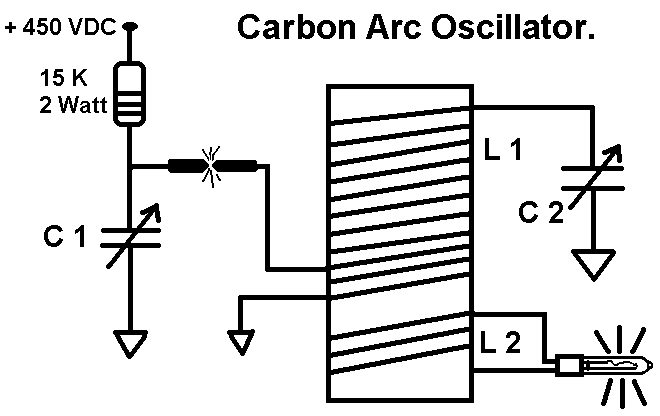Caution must be exercised when working with the high voltage and circuit shown here. In addition to the shock hazard, this oscillator generates a lot of RF energy and noise. It should only be used to light the lamp. Connection to any antenna or long wires should be avoided. It is illegal to use this circuit for any kind of signal transmission.
The carbon arc can be made by using a couple of pieces of mechanical pencil lead. Almost any size will do. I arbitrarily used HB hardness and tried several sizes. They all worked well, but the larger size seemed to be more stable. The power supply can be from an old tube radio or amplifier, or it can be built using rectifier diodes and 50 microfarad electrolytics capable of operation at 500 vdc. L1 can be 100 turns of enameled copper wire with a tap at every 10 turns. A good place to make the tap for the arc is about 20 to 30 turns. The top of the coil can be tapped anywhere from 70 to 100 turns. L2 which drives the lamp, is a separate coil of 8 turns of vinyl insulated wire wrapped around the outside of L1, near the ground end. The lamp used was a small 4 volt christmas tree lamp. C1 & C2 are 360 pf variable capacitors from old radios.
The setup that I made was very crude, but functionally, lived up to all of my expectations. The two pieces of lead were held in aligator clip leads and held together by hand. It is a good idea to mount the high voltage side carbon to the table and just hold the ground side carbon to avoid getting shocked. The two leads are touched lightly to start the arc and then held a small fraction of a millimeter apart to sustain the arc (which is sometimes difficult). If the arc is done carefully, the lamp will glow brightly, indicating the presence of some real RF energy.
The carbon arc transmitters were supposed to have worked on a principle of Negative Resistance from the carbon arc and indeed, they resemble oscillator circuits built around a tunnel diode. The circuit shown was built in an attempt to reproduce and observe the negative resistance characteristic of the carbon arc. Close examination of this circuit, however, seems to indicate that it is actually operating as a relaxation oscillator - much like the ones built with neon bulbs (but much more potent !!). C1 charges up to a voltage high enough to re-ionize the carbon arc and then discharges through it and part of L1, feeding L1 & C2 with a pulse of energy. An oscilloscope across C1 shows a sawtooth waveform. Using a 365 pf variable capacitor, the relaxation frequency can easily be adjusted to a frequency above 1 mhz. The arc transmitters of a past age had numerous refinements beyond what is shown here and this experiment does not necessarily discredit the negative resistance explanation of their operation.
